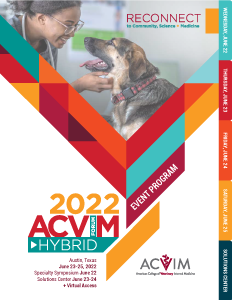Back
Please note, this session is not eligible for CE credit via on demand viewing. It is only available for CE credit if you attended the session live in person.
Scientific Session
Small Animal Internal Medicine
Examples of Difficult Diagnoses Made from Urine Sediment Analysis
Friday, June 24, 2022
2:45 PM – 3:45 PM CT
Location: Hilton Austin Grand Ballroom G
CE: 1

Harold W. Tvedten, DVM, PhD
clinical pathologist
Swedish Univ of Agric Sciences
Vange, Uppsala Lan, Sweden
Primary Presenter(s)
Performing urinalysis without looking at the urine sediment is like performing a complete blood count without looking at a blood smear (or instrument graphics). Urine sediment analysis should be performed often in small animal clinics and the microscopist should be able to identify well the common structures such as WBC, RBC, bacteria, and common casts and crystals. This lecture will describe uncommon but important structures in urine sediment that few can recognize. The intent is to challenge and stimulate microscopist to identify and interpret these structures.
Common casts in urine are hyaline and granular. Less common, previously described casts, are cell casts containing epithelial cells, WBC or RBC. Casts may be formed from precipitation of crystals into the lumen of renal tubules, but no textbooks describe crystal casts as a type of cast. Casts of oxalate crystals were reported in a dog with ketoacidosis diabetes. Poorly soluble substances (medicine) tested in pharmacology companies may cause casts of crystals of the test compound. Very many casts composed of uric acid were in 2 dogs’ urine with tumor lysis syndrome. Rare casts of uric acid/ urate crystals may be seen in Dalmatians.
Tubulorrhexis is rupture of renal tubules as a form of renal necrosis. Tubulorrhexis was diagnosed by the presence of fragments of renal tubules in the urine sediment of a dog with severe hemorrhagic shock3. Fragments of renal tubules differ from cell casts because the histological structure of the tubule remains and is not only the presence of individual epithelial cells inside casts.
Hematuria is readily identified by finding RBC in the urine sediment. Hemoglobinuria is usually identified by finding no RBC in the sediment in combination with a moderate to strong positive for blood on the dipstick. Hemoglobin can be found in the form of physical round droplets and not only dissolved in red transparent urine. Hemoglobin droplets are gold (hemoglobin) colored unstained and green-blue with a Wright’s stain. They are of different sizes and the drops can merge into larger drops. Their formation is temperature and pH dependent and they can appear or disappear with time. Hemoglobin droplets and hemaglobinuria are seen most often with intravascular hemolytic anemia such as IMHA. Hemoglobin droplets may be seen in hemoglobin casts such as in hemolytic anemia of red maple tree poisoning in horses. The author believes myoglobin droplets can look the same as hemoglobin droplets based in isolated cases of severe muscle damage in dogs and horses.
Common casts in urine are hyaline and granular. Less common, previously described casts, are cell casts containing epithelial cells, WBC or RBC. Casts may be formed from precipitation of crystals into the lumen of renal tubules, but no textbooks describe crystal casts as a type of cast. Casts of oxalate crystals were reported in a dog with ketoacidosis diabetes. Poorly soluble substances (medicine) tested in pharmacology companies may cause casts of crystals of the test compound. Very many casts composed of uric acid were in 2 dogs’ urine with tumor lysis syndrome. Rare casts of uric acid/ urate crystals may be seen in Dalmatians.
Tubulorrhexis is rupture of renal tubules as a form of renal necrosis. Tubulorrhexis was diagnosed by the presence of fragments of renal tubules in the urine sediment of a dog with severe hemorrhagic shock3. Fragments of renal tubules differ from cell casts because the histological structure of the tubule remains and is not only the presence of individual epithelial cells inside casts.
Hematuria is readily identified by finding RBC in the urine sediment. Hemoglobinuria is usually identified by finding no RBC in the sediment in combination with a moderate to strong positive for blood on the dipstick. Hemoglobin can be found in the form of physical round droplets and not only dissolved in red transparent urine. Hemoglobin droplets are gold (hemoglobin) colored unstained and green-blue with a Wright’s stain. They are of different sizes and the drops can merge into larger drops. Their formation is temperature and pH dependent and they can appear or disappear with time. Hemoglobin droplets and hemaglobinuria are seen most often with intravascular hemolytic anemia such as IMHA. Hemoglobin droplets may be seen in hemoglobin casts such as in hemolytic anemia of red maple tree poisoning in horses. The author believes myoglobin droplets can look the same as hemoglobin droplets based in isolated cases of severe muscle damage in dogs and horses.
Learning Objectives:
- This interactive session will aid users to be able to identify uncommon structures in the urine and interpret what they mean in regard to diagnosis.
- Be ready to interpet changes that occur rarely.
- Be flexible and not afraid to interperet the unusual.

